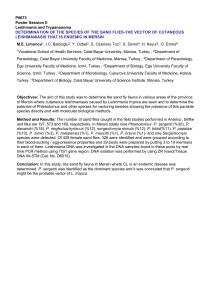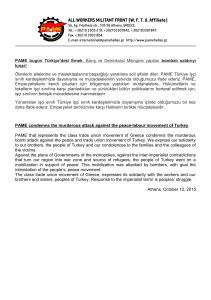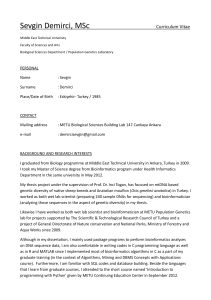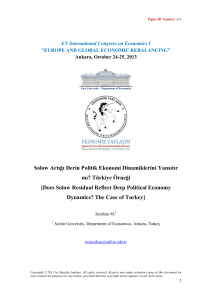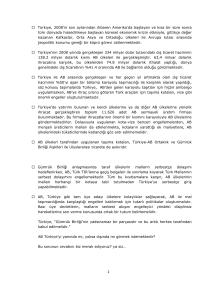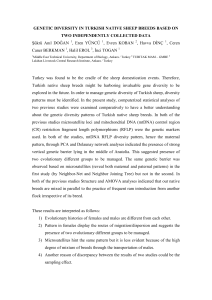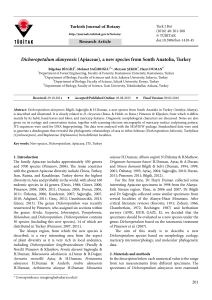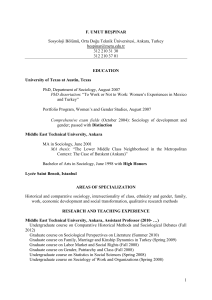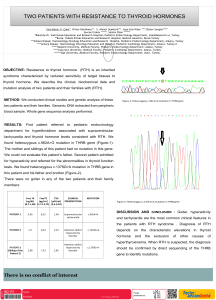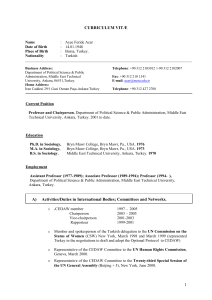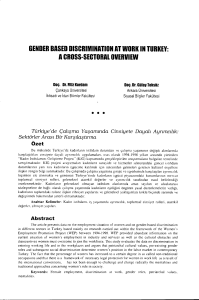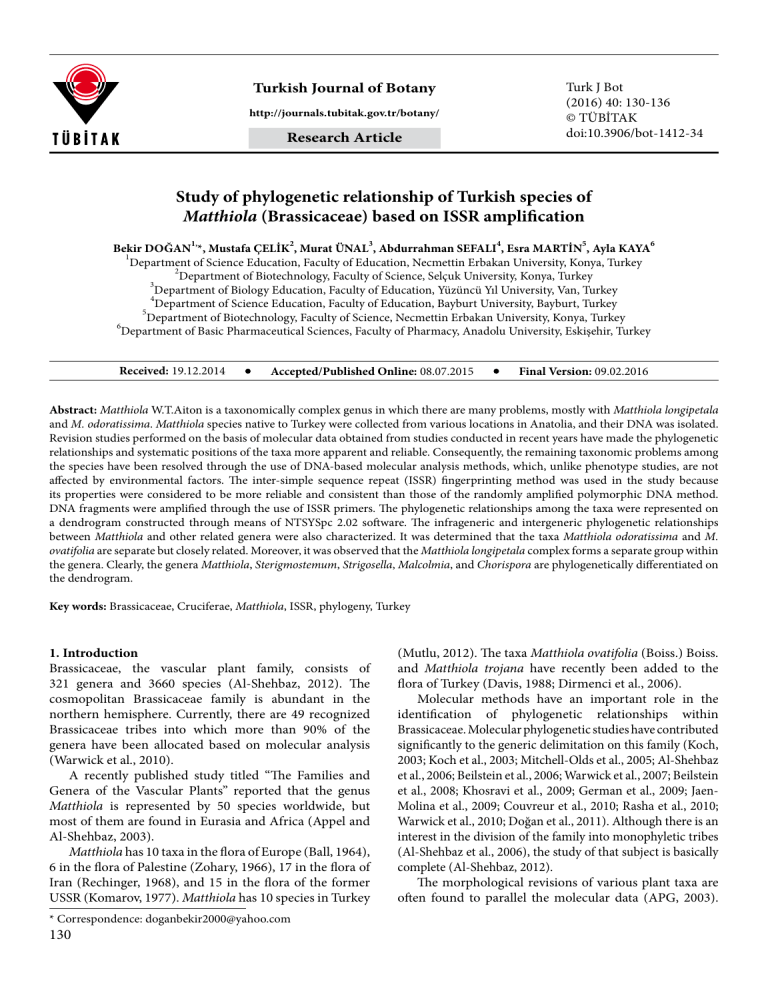
Turkish Journal of Botany
Turk J Bot
(2016) 40: 130-136
© TÜBİTAK
doi:10.3906/bot-1412-34
http://journals.tubitak.gov.tr/botany/
Research Article
Study of phylogenetic relationship of Turkish species of
Matthiola (Brassicaceae) based on ISSR amplification
1,
2
3
4
5
6
Bekir DOĞAN *, Mustafa ÇELİK , Murat ÜNAL , Abdurrahman SEFALI , Esra MARTİN , Ayla KAYA
1
Department of Science Education, Faculty of Education, Necmettin Erbakan University, Konya, Turkey
2
Department of Biotechnology, Faculty of Science, Selçuk University, Konya, Turkey
3
Department of Biology Education, Faculty of Education, Yüzüncü Yıl University, Van, Turkey
4
Department of Science Education, Faculty of Education, Bayburt University, Bayburt, Turkey
5
Department of Biotechnology, Faculty of Science, Necmettin Erbakan University, Konya, Turkey
6
Department of Basic Pharmaceutical Sciences, Faculty of Pharmacy, Anadolu University, Eskişehir, Turkey
Received: 19.12.2014
Accepted/Published Online: 08.07.2015
Final Version: 09.02.2016
Abstract: Matthiola W.T.Aiton is a taxonomically complex genus in which there are many problems, mostly with Matthiola longipetala
and M. odoratissima. Matthiola species native to Turkey were collected from various locations in Anatolia, and their DNA was isolated.
Revision studies performed on the basis of molecular data obtained from studies conducted in recent years have made the phylogenetic
relationships and systematic positions of the taxa more apparent and reliable. Consequently, the remaining taxonomic problems among
the species have been resolved through the use of DNA-based molecular analysis methods, which, unlike phenotype studies, are not
affected by environmental factors. The inter-simple sequence repeat (ISSR) fingerprinting method was used in the study because
its properties were considered to be more reliable and consistent than those of the randomly amplified polymorphic DNA method.
DNA fragments were amplified through the use of ISSR primers. The phylogenetic relationships among the taxa were represented on
a dendrogram constructed through means of NTSYSpc 2.02 software. The infrageneric and intergeneric phylogenetic relationships
between Matthiola and other related genera were also characterized. It was determined that the taxa Matthiola odoratissima and M.
ovatifolia are separate but closely related. Moreover, it was observed that the Matthiola longipetala complex forms a separate group within
the genera. Clearly, the genera Matthiola, Sterigmostemum, Strigosella, Malcolmia, and Chorispora are phylogenetically differentiated on
the dendrogram.
Key words: Brassicaceae, Cruciferae, Matthiola, ISSR, phylogeny, Turkey
1. Introduction
Brassicaceae, the vascular plant family, consists of
321 genera and 3660 species (Al-Shehbaz, 2012). The
cosmopolitan Brassicaceae family is abundant in the
northern hemisphere. Currently, there are 49 recognized
Brassicaceae tribes into which more than 90% of the
genera have been allocated based on molecular analysis
(Warwick et al., 2010).
A recently published study titled “The Families and
Genera of the Vascular Plants” reported that the genus
Matthiola is represented by 50 species worldwide, but
most of them are found in Eurasia and Africa (Appel and
Al-Shehbaz, 2003).
Matthiola has 10 taxa in the flora of Europe (Ball, 1964),
6 in the flora of Palestine (Zohary, 1966), 17 in the flora of
Iran (Rechinger, 1968), and 15 in the flora of the former
USSR (Komarov, 1977). Matthiola has 10 species in Turkey
*Correspondence: [email protected]
130
(Mutlu, 2012). The taxa Matthiola ovatifolia (Boiss.) Boiss.
and Matthiola trojana have recently been added to the
flora of Turkey (Davis, 1988; Dirmenci et al., 2006).
Molecular methods have an important role in the
identification of phylogenetic relationships within
Brassicaceae. Molecular phylogenetic studies have contributed
significantly to the generic delimitation on this family (Koch,
2003; Koch et al., 2003; Mitchell-Olds et al., 2005; Al-Shehbaz
et al., 2006; Beilstein et al., 2006; Warwick et al., 2007; Beilstein
et al., 2008; Khosravi et al., 2009; German et al., 2009; JaenMolina et al., 2009; Couvreur et al., 2010; Rasha et al., 2010;
Warwick et al., 2010; Doğan et al., 2011). Although there is an
interest in the division of the family into monophyletic tribes
(Al-Shehbaz et al., 2006), the study of that subject is basically
complete (Al-Shehbaz, 2012).
The morphological revisions of various plant taxa are
often found to parallel the molecular data (APG, 2003).
DOĞAN et al. / Turk J Bot
Unlike morphological data, DNA data are not influenced
by the environmental conditions in which the plants have
grown, and consequently DNA is a powerful tool in the
identification of solutions to taxonomical and systematical
problems.
The randomly amplified polymorphic DNA (RAPD)
fingerprinting method is widely used and has a wide range
of applications (Williams et al., 1990). However, because
RAPD is a highly sensitive method, it should be used
with great care. The inter-simple sequence repeat (ISSR)
method has much higher levels of reproducibility than
RAPD, for which reason it is preferable (Zietkiewicz et al.,
1994; Prevost & Wilkinson, 1999; Dogan et al., 2007; Hakki
et al., 2010). The ISSR method is very widely used for the
analysis of genetic diversity (Prevost and Wilkinson, 1999).
German et al. (2009), in their study on members
of the Asian Brassicaceae, determined that the tribe
Anchonieae is monophyletic. A recent molecular study
of Iranian Matthiola species revealed that the genus is
not monophyletic but is instead polyphyletic (Khosravi
et al., 2009). Another study reported that Macaronesian
Matthiola endemics are of an independent monophyletic
origin (Jaen-Molina et al., 2009).
No molecular study of the Matthiola species present in
Turkey has been conducted. This study aims to determine
the status of the taxonomically problematic species among
the Matthiola species based on the molecular phylogenetic
relationships and to characterize the phylogenetic
relationships between the Matthiola species and their close
relatives.
2. Materials and methods
2.1. Plant materials
Matthiola and the specimens of other genera used in
this study were collected from Sivas, İstanbul, Sinop,
Niğde, Mardin, Antalya, Bursa, Artvin, Çanakkale, İzmir,
Balıkesir, and Van by the authors during the period of
2012–2013 (Figure 1). Standard herbarium methods were
used to dry the collected specimens. The specimens were
marked with collection numbers. The flora that were used
in the identification of the plant samples are the Flora of
Turkey (Cullen, 1965), Flora Iranica (Rechinger, 1968),
Flora Europaea (Ball, 1964), Flora of Iraq (Townsend,
1980), Flora of the USSR (Komarov, 1977), Flora Palaestina
(Zohary, 1966), and Flora of Cyprus (Meikle, 1977). The
collected plant specimens are kept at the Yüzüncü Yıl
University Faculty of Science and Art, Department of
Biology (VANF). The locations of the collected samples
and the examined representative specimens can be found
in the Appendix. The genera Sterigmostemum, Malcolmia,
Strigosella, and Chorispora were chosen as the out-groups.
2.2. DNA isolation
DNA was isolated from leaves dried in silica gel and
leaves taken from the herbarium materials. The total
DNA was obtained from 50–75 mg of dried leaf tissues
from 10 different samples. DNA isolation was conducted
using the Easy Nucleic Acid Isolation Kit (Omega), and
the concentrations were determined using a NanoDrop
Spectrophotometer (Thermo Fisher Scientific, USA;
Sambrook et al., 1989). The sample DNA was diluted to 25
ng/µL. Unused DNA samples were kept at ­–86 °C.
Figure 1. Distribution map of the examined specimens of the genera Matthiola,
Sterigmostemum, Malcolmia, and Chorispora. 1- Matthiola anchoniifolia,
2- M. fruticulosa subsp. fruticulosa, 3- M. incana, 4- M. longipetala subsp. longipetala,
5- M. longipetala subsp. bicornis, 6- M. longipetala subsp. pumilio, 7- M. montana,
8- M. odoratissima, 9- M. ovatifolia, 10- M. sinuata, 11- M. tricuspidata, 12M. trojana, 13- M. sp., 14- Sterigmostemum incanum, 15- S. sulphureum, 16Strigosella africana, 17- Malcolmia flexuosa, 18- Chorispora purpurascens.
131
DOĞAN et al. / Turk J Bot
2.2.1. ISSR amplifications
PCR amplification using ISSR primers (Domenyuk et
al., 2002; Galvan et al., 2003) were carried out by means
of an Eppendorf Mastercycler Gradient Thermocycler
(USA). Each 25-µL PCR reaction consisted of 2.5 µL of
PCR buffer (10 mM TRIS/50 mM KCl buffer, pH 8.0), 3
µL of 25 mM MgCl, 0.5 µL of each primer, 0.5 µL of dNTP
mix, 0.4 µL of Taq DNA polymerase (Bioron), 4 µL of
template DNA, and 14.1 µL of distilled water. Following
the predenaturation step at 94 °C for 3 min, amplification
reactions were cycled 40 times at 94 °C for 1 min, at the
appropriate annealing temperature (Table) for 1 min, and
at 72 °C for 1 min. A final extension was carried out at 72
°C for 10 min. After the completion of the reaction, 15µL aliquots of the PCR products were mixed with 3 µL of
loading dye (50% glycerol, 0.25% bromophenol blue, and
0.15% xylene cyanol) and loaded onto a 2% agarose, 1X
Tris-borate-EDTA gel and then electrophoresed at 4 V
cm–1. Amplifications were carried out with a minimum
of two repetitions (at independent times) for each primer
and the same reagents and procedures were used in each
repetition. Reactions without template DNA were used
as negative controls. The optimal annealing temperature
was determined for each primer. The characteristics of the
primers are shown in the Table.
2.3. Data collection and phylogenetic analysis
The amplified fragments were visualized under a
UV transilluminator and photographed using a gel
documentation system (Vilbert Lourmat, Germany). All
amplified fragments were treated as dominant genetic
markers. Each generated DNA band was visually scored
as an independent character or locus (‘1’ for presence
and ‘0’ for absence). Qualitative differences in band
intensities were not taken into consideration. Each gel
was scored in triplicate through independent scorings
and only the fragments that received consistent scores
were considered for analysis. A rectangular binary data
matrix was prepared, and all data analysis was conducted
through use of the Numerical Taxonomy System, NTSYSpc version 2.02 (Applied Biostatistics, USA). The similarity
coefficient method was used. The unweighted pair-group
method with the arithmetic mean (UPGMA) procedure
was used for cluster analysis of samples (Rohlf, 1992). The
genetic distances were calculated with the SM coefficient.
In order to determine the ability of ISSR data to display the
interrelationships among the samples, principle coordinate
analysis (PCA) of pairwise genetic distances (Nei, 1972)
was also conducted using the NTSYS-pc package.
3. Results and discussion
An initial screening of 24 ISSR primers revealed that
seven primers had high levels of polymorphism. Eightyone highly polymorphic fragments were generated by
those primers, which were consistently amplified in the
repeated experiments conducted on different dates. The
GC percentages of the selected primers ranged from 38.9%
to 68.4%. The Table shows the characteristics and the
sequences of the primers that best revealed polymorphism.
In the overall analysis, it was found that the average number
of polymorphic fragments per primer used was roughly
11. ISSR M2 and ISSR F2 banding patterns are represented
in Figure 2. The genetic distances calculated by the SM
coefficient ranged from 0.54 to 0.97. Four genera and 10
species were determined as a result of the analysis of the
scored ISSR bands. The dendrogram based on the ISSR
bands showed two major clades, one of which contained
Matthiola, while the other contained the out-groups
(Sterigmostemum, Strigosella, Malcolmia, and Chorispora)
(Figure 3). The genera Malcolmia and Chorispora were
found to be phylogenetically highly similar. A correlation
was detected between the morphologically diagnostic
characters and the molecular taxonomic classification.
The differences among the closely related species became
apparent in the results of PCA (Figure 4).
Table. ISSR primers used in this study and their specifications (Domenyuk et al., 2002; Galvan et al., 2003).
132
Primer
Primer sequence
Tm (°C)
Size (bp)
GC%
Tan
ISSR M1
(AGC)6-G
63.1
19
68.4
63
ISSR M2
(ACC) -G
63.1
19
68.4
63
ISSR M3
(AGC) -C
63.1
19
68.4
63
ISSR M5
(GA)9-C
56.7
19
56.7
56
ISSR F1
GAG-(CAA)5
49.1
18
38.9
49
ISSR F2
CTC-(GT)
56.7
19
52.6
56
ISSR F3
(AG) -CG
56
18
55.6
56
6
6
8
8
DOĞAN et al. / Turk J Bot
Figure 2. Representative agarose gels where PCR products were amplified with the
primers ISSR M2 (A) and ISSR F2 (B). 1- Matthiola anchoniifolia, 2- M. fruticulosa
subsp. fruticulosa, 3- M. incana, 4- M. longipetala subsp. longipetala, 5- M. longipetala
subsp. bicornis, 6- M. longipetala subsp. pumilio, 7- M. montana, 8- M. odoratissima,
9- M. ovatifolia, 10- M. sinuata, 11- M. tricuspidata, 12- M. trojana, 13- M. sp.,
14- Sterigmostemum incanum, 15- S. sulphureum, 16- Strigosella africana, 17- Malcolmia
flexuosa, 18- Chorispora purpurascens.
Figure 3. Dendrogram showing genetic relationship of Matthiola, Sterigmostemum,
Malcolmia, Strigosella, and Chorispora species based on ISSR markers.
The Matthiola species were located in the same clade,
while the other species were placed in a separate clade on
the phylogenetic dendrogram. The Sterigmostemum and
Chorispora genera, which were selected as out-groups,
typically have multicellular glands and are found in various
genera of the Brassicaceae family. Given that Malcolmia
species have dendroid hairs, it is not surprising that they
are phylogenetically close.
Comparing the identification key and the molecular
dendrogram of the genus Matthiola in the flora of Turkey,
the species Matthiola anchoniifolia and M. incana, the fruit
of which is flat and has no horn at the tip, were found to
133
DOĞAN et al. / Turk J Bot
Figure 4. Principal coordinate analysis of Matthiola,
Sterigmostemum, Malcolmia, and Chorispora. 1- Matthiola
anchoniifolia, 2- M. fruticulosa subsp. fruticulosa, 3- M. incana,
4- M. longipetala subsp. longipetala, 5- M. longipetala subsp.
bicornis, 6- M. longipetala subsp. pumilio, 7- M. montana, 8- M.
odoratissima, 9- M. ovatifolia, 10- M. sinuata, 11- M. tricuspidata,
12- M. trojana, 13- M. sp., 14- Sterigmostemum incanum, 15- S.
sulphureum, 16- Strigosella africana, 17- Malcolmia flexuosa,
18- Chorispora purpurascens.
be morphologically similar and also close in the molecular
dendrogram. In the other group with horned and terete
fruits, Matthiola longipetala formed one group while
M. fruticulosa, M. trojana, and M. tricuspidata formed
another. Matthiola longipetala subsp. longipetala and
M. longipetala subsp. bicornis, which were very difficult
to separate in our collection of plant samples, were very
closely located on the dendrogram. Moreover, those two
subspecies are not geographically isolated, as is the case
with the third geographical subspecies M. longipetala
subsp. pumilio. In another molecular study on Matthiola,
M. longipetala subsp. viridis was clearly separate from
M. longipetala subsp. pumilio and M. longipetala subsp.
bicornis (Jaen-Molina et al., 2009).
Matthiola montana was clearly separate from the
remainder of the genus. This separation, based on
molecular data, is consistent with its morphological
separation, which is in turn based on the fact that its fruit
hairless. Matthiola odoratissima and M. ovatifolia are
morphologically very similar to one another. According
to the molecular data obtained from this study, these
two taxa are separate but very closely related species. The
specimen given as Matthiola sp. is believed to be a new
species that is closely related to the aforementioned two
taxa. This specimen, collected from the Van district, is
morphologically different from Matthiola ovatifolia and
molecularly separated on the dendrogram.
Our study placed Matthiola fruticulosa within the same
clade as the M. longipetala complex, while, in another
study, it was similarly located in the same clade and the
two were closely located within the genus (Jaen-Molina et
al., 2009).
Matthiola incana is the most studied Matthiola species
in the scientific literature worldwide. It is morphologically
similar to Matthiola anchoniifolia. These two are also
located morphologically close on the dendrogram. In
another study, the species M. incana was shown to be closely
related to M. sinuata (Jaen-Molina et al., 2009). Matthiola
trojana is an endemic species that was introduced to the
world of science a few years ago (Dirmenci et al., 2006).
It is molecularly close to the species Matthiola fruticulosa,
which is also morphologically perennial and has horns.
The Turkish Matthiola taxa were evaluated as
monophyletic in the dendrogram examination. However,
the Iranian Matthiola taxa were reported as polyphyletic
(Khosravi et al., 2009). In another study, the Anchoniaeae
tribe, which contains some Asian Matthiola taxa, was
reported to be monophyletic (German et al., 2009).
The study by Warwick et al. (2010) reported that the
Anchonieae tribe, which includes the Matthiola genus, is
monophyletic.
In conclusion, the morphologically close taxa were, in
the molecular aspect, also located in the same clade. The
genera used as out-groups (Sterigmostemum, Strigosella,
Malcolmia, and Chorispora) were clearly separate from the
genus Matthiola. In another study, the genus Chorispora
was determined as the closest out-group (Jaen-Molina et
al., 2009).
Acknowledgment
The authors are grateful to Yüzüncü Yıl University (BAP
Project No. 2012-EF-B009) for its financial support during
this study.
References
Al-Shehbaz IA (2012). A generic and tribal synopsis of the Brassicaceae
(Cruciferae). Taxon 61: 931–954.
Al-Shehbaz IA, Beilstein MA, Kellogg EA (2006). Systematics and
phylogeny of the Brassicaceae (Cruciferae): an overview. Plant
Syst Evol 259: 89–120.
134
Appel O, Al-Shehbaz IA (2003). Matthiola R.Br. In: Kubitzki K,
Bayer C, editors. The Families and Genera of vascular plants.
Flowering plants, Dicotyledons: Malvales, Capparales, and NonBetalanin Caryophyllales. Vol. 5. Berlin, Germany: SpringerVerlag. p. 140.
DOĞAN et al. / Turk J Bot
APG (2003). An update of the Angiosperm Phylogeny Group
classification for the orders and families of flowering plants:
APG II. Bot J Linn Soc 141: 399–436.
Ball PW (1964). Matthiola R.Br. In: Tutin TG, Heywood VH, Burges
NA, Valentine DH, Walters SM, Webb DA, editors. Flora
Europaea. Vol. 1. Cambridge, UK: Cambridge University Press,
pp. 340–341.
Beilstein MA, Al-Shehbaz IA, Kellogg EA (2006). Brassicaceae
phylogeny and trichome evolution. Am J Bot 93: 607–619.
Beilstein MA, Al-Shehbaz IA, Mathews S, Kellogg EA (2008).
Brassicaceae phylogeny inferred from phytochrome A and
NDHF sequence data: tribes and trichomes revisited. Am J Bot
95: 1307–1327.
Couvreur TLP, Franzke A, Al-Shehbaz IA, Bakker FT, Koch MA,
Mummenhoff K (2010). Molecular phylogenetics, temporal
diversification and principles of evolution in the mustard family
(Brassicaceae). Mol Biol Evol 27: 55–71.
Cullen J (1965). Matthiola R.Br. In: Davis PH, editor. Flora of Turkey
and the East Aegean Islands. Vol. 1. Edinburgh, UK: Edinburgh
University Press, pp. 447–450.
Davis PH, Tan K, Mill RR, editors (1988). Flora of Turkey and the East
Aegean Islands, Vol. 10. Edinburgh, UK: Edinburgh University
Press.
Dirmenci T, Satıl F, Tümen G (2006). A new species of Matthiola R. Br.
(Brassicaceae) from Turkey. Bot J Linn Soc 151: 431–435.
Dogan B, Duran A, Hakki EE (2007). Phylogenetic analysis of Jurinea
(Asteraceae) species from Turkey based on ISSR amplification.
Ann Bot Fenn 44: 353–358.
Doğan B, Ünal M, Özgökçe F, Martin E, Kaya A (2011). Phylogenetic
relationships between Malcolmia, Strigosella, Zuvanda, and
some closely related genera (Brassicaceae) from Turkey revealed
by inter-simple sequence repeat amplification. Turk J Bot 35:
17–23.
Domenyuk VP, Verbitskaya TG, Belousov AA, Sivolap YM (2002).
Marker analysis of quantitative traits in maize by ISSR-PCR.
Russian J Genet 38: 1161–1168.
Galvan MZ, Bornet B, Balatti PA, Branchard M (2003). Inter simple
sequence repeat (ISSR) markers as a tool for the assessment of
both genetic diversity and gene pool origin in common bean
(Phaseolus vulgaris L.). Euphytica 132: 297–301.
German DA, Friesen N, Neuffer B, Al-Shehbaz IA, Hurka H (2009).
Contribution to ITS phylogeny of the Brassicaceae, with a
special reference to some Asian taxa. Plant Syst Evol 283: 33–56.
Hakki EE, Dogan B, Duran A, Martin E, Dinc M (2010). Phylogenetic
relationship analysis of Genista L. (Fabaceae) species from Turkey
as revealed by inter-simple sequence repeat amplification. Afr J
Biotechnol 9: 2627–2632.
Jaen-Molina R, Caujape-Castells J, Reyes-Betancort JA, Akhani H,
Fernandez-Palacios O, Paz JP, Fables-Hernandez R, MarreroRodriguez A (2009). The molecular phylogeny of Matthiola R.
Br. (Brassicaceae) inferred from ITS sequences, with special
emphasis on the Macaronesian endemics. Mol Phylogenet Evol
53: 972–981.
Khosravi AR, Mohsenzadeh S, Mummenhoff K (2009). Phylogenetic
relationships of Old World Brassicaceae from Iran based on
nuclear ribosomal DNA sequences. Biochem Syst Ecol 37: 106–
115.
Koch M (2003). Molecular phylogenetics, evolution and population
biology in the Brassicaceae. In: Sharma AK, Sharma A, editors.
Plant Genome: Biodiversity and Evolution, Vol. 1. Phanerogams.
Enfield, NH, USA: Science Publishers, pp. 1–35.
Koch M, Al-Shehbaz IA, Mummenhoff K (2003). Molecular
systematics, evolution, and population biology in the mustard
family (Brassicaceae). Ann Mo Bot Gard 90: 151–171.
Komarov VL (1977). Matthiola R.Br. In: Komarov VL, editor. Flora of
the USSR. Vol. VIII (Translated from Russian). Jerusalem: Israel
Program for Scientific Translation, pp. 212–221.
Meikle RD (1977). Flora of Cyprus, Vol. 1. Kew, UK: Royal Botanic
Gardens.
Mitchell-Olds T, Al-Shehbaz IA, Koch M, Sharbel TF (2005). Crucifer
evolution in the post-genomic era. In: Henry RJ, editor. Plant
Diversity and Evolution: Genotypic and Phenotypic Variation
in Higher Plants. Wallingford, UK: CAB International, pp.
119–137.
Mutlu B (2012). Matthiola Aiton. In Güner A, Aslan S, Ekim T,
Vural M, Babaç MT, editors. Türkiye Bitkileri Listesi (Damarlı
Bitkiler). İstanbul, Turkey: Nezahat Gökyiğit Botanik Bahçesi ve
Flora Araştırmaları Derneği Yayını, pp. 287–288 (in Turkish).
Nei M (1972). Genetic distance between populations. Am Nat 106:
283–292.
Prevost A, Wilkinson M J (1999). A new system of comparing PCR
primers applied to ISSR fingerprinting of potato accessions.
Theor Appl Genet 98: 107–112.
Rasha K, Soliman KA, Rashed AKF, Ibrahim SA (2010). Genetic
polymorphism of some medicinal plants belonging to
Brassicaceae using molecular markers. Egypt J Genet Cytol 39:
41–55.
Rechinger KH (1968). Matthiola R.Br. In: Rechinger KH, editor.
Flora Iranica, Vol. 57. Graz, Austria: Akademische Druck-u
Verlagsanstalt, pp. 228–240.
Rohlf FJ (1992). NTSYS-pc: Numerical Taxonomy and Multivariate
Analysis System, Version 2.0. Setauket, NY, USA: Exeter.
Sambrook J, Fritsch EF, Maniatis T (1989). Molecular Cloning: A
Laboratory Manual. 2nd ed. Cold Spring Harbor, NY, USA:
Cold Spring Harbor Laboratory Press.
Townsend CC (1980). Matthiola R.Br. In: Townsend CC, Guest
E, editors. Flora of Iraq. Vol. 4. Baghdad, Iraq: Ministry of
Agriculture of the Republic of Iraq, pp. 1028–1031.
Warwick SI, Mummenhoff K, Sauder CA, Koch MA, Al-Shehbaz
IA (2010). Closing the gaps: phylogenetic relationships in the
Brassicaceae based on DNA sequence data of nuclear ribosomal
ITS region. Plant Syst Evol 285: 209–232.
135
DOĞAN et al. / Turk J Bot
Warwick SI, Sauder C, Al-Shehbaz IA, Jacquemoud F (2007).
Phylogenetic relationships in the tribes Anchonieae,
Choripsoreae, Euclideae, and Hesperideae (Brassicaceae) based
on nuclear ribosomal ITS DNA sequences. Ann Mo Bot Gard
94: 56–78.
Williams JGK, Kubelik AR, Livak KJ (1990). DNA polymorphism
amplified by arbitrary primers are useful as genetic markers.
Nucleic Acids Res 18: 6531–6535.
136
Zietkiewicz E, Rafalski A, Labuda D (1994). Genome fingerprinting
by simple sequence repeat (SSR)-anchored polymerase chain
reaction amplification. Genomics 20: 176–183.
Zohary M (1966). Matthiola R.Br. In: Zohary M, editor. Flora
Palaestina, Vol. 1. Jerusalem, Israel: Academic Press, pp. 270–
274.
DOĞAN et al. / Turk J Bot
Appendix.
Examined representative specimens: – Matthiola
anchoniifolia. Turkey. B6: Sivas, Gürün, Gökpınar köyü
yolu, 4. km jipsli step, 1474 m, 38°39′215″N; 37°18′164″E,
21.07.2013, ASEFMU 10201, VANF 164023. – Matthiola
fruticulosa subsp. fruticulosa. A2: İstanbul, Sarıyer, Kumköy
(Kilyos), kumullar, 4 m, 41°14′415″N; 29°00′554″E,
18.06.2012, ASEFMU 10202, VANF 164024. – Matthiola
incana. A5: Sinop, Merkez, Sinop kalesi, sur üzerleri, 10 m,
42°01′468″N; 35°08′704″E, 30.08.2013, MUASEF 10188,
VANF 164025. – Matthiola longipetala subsp. longipetala.
C5: Niğde, Konya’dan Ulukışla’ya 15. km kala, yol kenarı,
step, 1281 m, 37°36′284″N; 34°24′146″E, 14.05.2013,
MUASEF 10203, VANF 164026. – Matthiola longipetala
subsp. bicornis. C8: Mardin, Savur, Sürgücü köyünden
Savur ilçesine doğru 5. km, step, 918 m, 37°30′159″N;
40°38′238″E, 15.05.2013, MUASEF 10204, VANF 164027.
– Matthiola longipetala subsp. pumilio. C3: Antalya,
Murat Paşa, Lara, açıklık alanlar, 25 m, 36°50′558″N;
30°46′282″E, 06.04.2013, ASEFMU 10205, VANF 164028
– Matthiola montana. A2: Bursa, Uludağ, Kuşaklı kaya
ile Şahinkaya tepeleri arası, Şahinkaya tepenin şehre
doğru olan yamaçları, kireçtaşı ve granitten oluşan
kayalık setler içi, 2153 m, 40°05′230″N, 29°09′230″E,
07.09.2012, MUASEF 10208, VANF 164029. – Matthiola
odoratissima. A8: Artvin, Yusufeli, Olur ile Yusufeli İlçeleri
arası Bulanık köprüsü çevresi, Dere kenarı, dik yamaçlar,
757 m, 40°45′558″N; 30°46′282″E, 31.08.2013, MUASEF
10189, VANF 164030. – Matthiola ovatifolia. B6: Sivas,
Gürün-Darende arası 3. km, step, 1447 m; 38°41′339″N;
37°23′147″E, 20.08.2013, ASEFMU 10209, VANF 164031.
– Matthiola sinuata. A1: Çanakkale, Seddülbahir (Helles),
kumullar, 14 m, 40°02′342″N; 26°11′112″E, 06.05.2012,
ASEFMU 10210, VANF 164032. – Matthiola tricuspidata.
B1: İzmir, Çeşme, Çiftlik köyü, Altınkum sahilleri, 13
m, 38°16′207″N; 26°15′639″E, 10.04.2013, MUASEF
10206, VANF 164033. – Matthiola trojana. B1: Balıkesir,
Edremit, Kaz Dağı, Nanekırı mevkii, Anakayası kireçtaşı
olan kayalık bloklar arasında, kaya çatlaklarında, 1594
m, 39°41′899″N, 26°53′106″E, 08.09.2012, MUASEF
10207, VANF 164034. – Matthiola sp. B9: Van, Gürpınar,
Taşdöndüren köyü yolu, yol kenarı, eğimli step alanlar,
2002 m, 38°17′081″N, 43°48′543″E, 08.07.20013, MUASEF
10198, VANF 164035. – Sterigmostemum incanum. A8
Artvin; Yusufeli den Olur’a giderken yol kenarı, step, 731
m, 40°45′481″N; 41°45′097″E, 06.05.2013, MUASEF 12712,
VANF 164036. Sterigmostemum sulphureum. B9: Van,
Yüzüncü Yıl Üniversitesi Kampüsü TOKİ lojmanlarından
göle doğru, step, 1662 m, 38°33′438″N; 43°17′324″E,
10.05.2013, MUASEF 12711, VANF 164037. –Strigosella
africana. B9: Van, Gürpınar, Üçgen köyü yolu kenarı
köprü çevreleri, kumul alanlar, 2027 m, 38°21′489″N;
43°46′162″E, 11.05.2009, MUASEF 10157, VANF 164038.
– Malcolmia flexuosa. B1: İzmir, Seferihisar, Sığırcak
köyü, Ekmeksiz koyu, kayalık alanlar, 15 m, 38°10′270″N;
26°46′240″E, ASEFMU 10163, VANF 164039. – Chorispora
purpurascens C7: Şanlıurfa, Birecik, Birecik’ten Gaziantep’e
doğru giderken 10. km, fıstık tarlaları yakınları, 450 m,
37°00′400″N; 37°51′538″E, 10.04.2013. MUASEF 12713,
VANF 164040.
1


